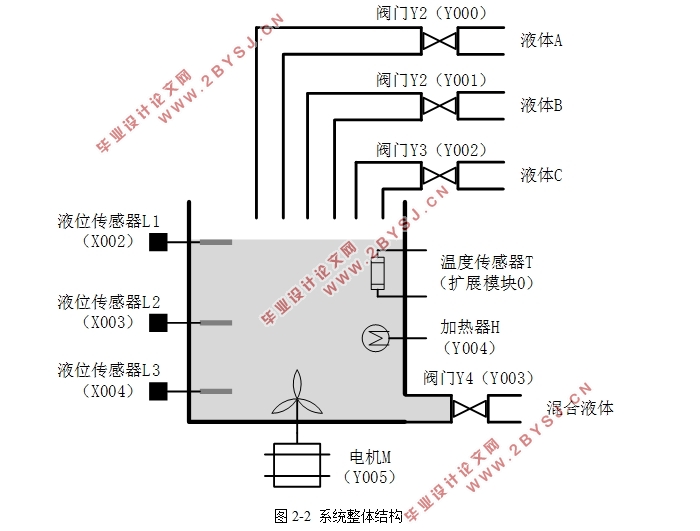多种液体混合PLC控制系统设计
无需注册登录,支付后按照提示操作即可获取该资料.
多种液体混合PLC控制系统设计(论文12000字)
摘要:随着工业自动化系统的不断进步,多种液体混合系统正朝着性能可靠、使用简单的方向发展。本文以PLC技术为基础,设计了一种具备对多种液体进行混合功能的控制系统。该系统使用了多个电磁阀来控制多种液体注入混合容器的过程;而为了确定注入容器中每种液体的体积,使用了液位传感器来对液面高度进行监控;而使用搅拌电机对多种液体进行固定时常的混合作业;另外,为了控制液体混合过程中的温度,使用了加热器和温度传感器;而为了避免液体混合作业过程中发生意外,设置了紧急停止按钮。最后对所设计出的多种液体混合系统进行了仿真测试,结果表明该系统的核心功能可以顺利的完成。
关键词:多种液体;液体混合;PLC
Design of Multiple Liquids Mixing PLC Control System
Abstract:With the continuous improvement of industrial automation systems, multiple liquids mixing systems are moving toward to stable performance and ease of using. This paper designed a control system based on PLC which can mix multiple liquids.The system used some solenoid valves to control the flow of multiple liquids into the mixing vessel. And in order to determine the volume of each liquid injected into the vessel, a level sensor is used to monitor the level of the liquid. And a stirring motor is often used to mix multiple liquids. In addition, a heater and a temperature sensor are used to control the temperature during the liquid mixing work. And an emergency stop button was provided to avoid an accident during the liquid mixing operation. Finally, the simulation tests of multiple liquids mixing system were carried out. The result shows that the core functions of the system can be successfully completed.
Key words:multiple liquids; liquids mixing; PLC
三菱公司所生产的FX系列PLC是工业控制中常用的一类PLC。FX型PLC将电源、处理器、输入、输出以及存储器集成为一个单元,且AC电源、DC输入型号的内部还具有DC-24V电源,可作为传感器的供电电源使用。同时,FX型PLC的核心单元和扩展功能单元采用脱卸式端子排,以便降低其维护难度。标准配置内置有8K的RAM存储器,并通过电池供电,而如果使用了存储盒配件则存储空间可扩充至16K,同时存储器类型可在RAM、EEPROM、EPROM三者中进行选择。同时FX型PLC具有内部时钟功能,可以十分容易的进行时间控制。本课题具体基于三菱公司生产的FX2N型号PLC进行控制系统设计。

目录
1 绪论 1
1.1 可编程控制器特点和发展 1
1.2 本课题研究现状 1
1.2.1 国外现状............................................................2
1.2.2 国内现状............................................................2
2 多种液体混合PLC硬件设计 2
2.1 FX系列PLC 3
2.2 FX2N-4AD-PT扩展模块介绍 3
2.3 系统整体设计 5
2.4 系统资源分配 6
3 多种液体混合系统的软件设计 8
3.1 GX Developer软件介绍 8
3.2 控制系统梯形图设计 10
3.3 系统工作流程 12
4 多种液体混合系统的仿真测试 15
4.1 GX Simulator介绍 15
4.2 仿真测试 16
5 实验验证 19
5.1实验接线 19
5.2 实验步骤...............................................................21
6 结论与讨论.............................................25
参考文献: 25
致谢 27
